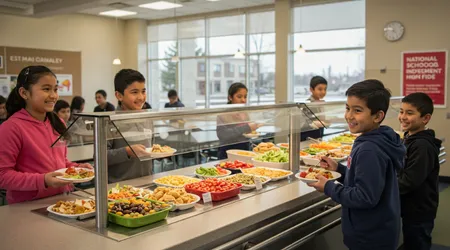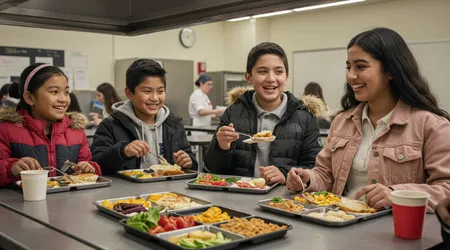National School Food Program: What the $1B Investment Means for Canadian Kids

The National School Food Program, announced in Budget 2024, marks a historic step for Canada, the last G7 nation without a universal school meal initiative.
With a $1 billion investment over five years, this program aims to feed 400,000 more children annually, easing family budgets and boosting kids’ health and learning. It’s a bold move, but what does it really mean for Canadian kids?
Beyond filling bellies, it’s about leveling the playing field, fostering equity, and investing in a generation’s future.
Let’s unpack the ripple effects of this landmark policy, from classrooms to communities, and explore why it’s more than just lunch.
This initiative arrives at a critical time. With grocery prices soaring Statistics Canada reported a 22.3% rate of family food insecurity in 2022 it’s no surprise families are struggling.
Kids going to school hungry face barriers to learning, from poor focus to lower attendance. The National School Food Program isn’t just about meals; it’s a social equalizer, a health intervention, and an economic boost.
By weaving together insights from educators, nutritionists, and families, we’ll dive into how this program reshapes childhoods and communities, with practical examples and real-world impacts.
Nourishing Bodies, Sharpening Minds
Imagine a child, Sarah, in Grade 5, who skips breakfast because her parents are stretched thin. Hunger gnaws at her focus, making math class a blur.
The National School Food Program changes this. By providing consistent, nutritious meals, it ensures kids like Sarah can concentrate, learn, and thrive.
Studies show well-fed students have better academic outcomes attendance rises, grades improve, and classroom behavior steadies.
A 2021 Swedish study found free school lunches boosted lifetime earnings by 3%, with low-income kids gaining even more.
This isn’t just about filling stomachs; it’s about fueling potential. Hungry kids struggle with memory and problem-solving, but a balanced meal can turn that around.
In Ontario, where $108.5 million over three years will serve 9.8 million meals annually, schools are already seeing the difference. Kids are more engaged, less irritable.
++ Abortion of Carbon Tax: What Mark Carney’s 2025 Move Means for Consumers
Why wouldn’t we invest in something that so directly shapes a child’s ability to succeed? The National School Food Program is a lifeline for learning.
But the benefits extend beyond the classroom. Healthy meals reduce risks of obesity, diabetes, and other chronic conditions.
By aligning with Canada’s Food Guide, the program prioritizes whole foods over processed snacks, setting kids up for long-term wellness.
Schools in Newfoundland and Labrador, the first province to sign on, report kids choosing apples over chips, a small but seismic shift in habits. This isn’t just lunch it’s a foundation for healthier lives.

Easing the Burden on Families
Picture a single parent, Mark, juggling two jobs and rising grocery bills. Packing lunches feels like another tax on his time and wallet.
The National School Food Program lifts this weight, saving families like his up to $800 a year for two kids, per government estimates.
That’s money for rent, clothes, or extracurriculars choices no parent should forgo because of food costs. In Manitoba, where $17 million in federal funds bolsters local programs, parents report less stress and more financial breathing room.
Also read: Inflation Relief and Sales Tax Freeze: How Canadians Benefit in Winter 2025
This relief is a game-changer for low-income households, where food insecurity hits hardest. The program targets those most in need, like racialized minorities and remote communities, ensuring equity in access.
In Ontario’s First Nations Student Nutrition Program, 130,000 additional meals this year reach Indigenous kids, addressing disparities head-on. It’s not charity; it’s fairness, giving every child a shot at success regardless of their family’s income.
Beyond savings, the program frees up time. Parents no longer need to prep lunches daily, a small but real reduction in mental load.
In British Columbia, where $214 million over three years expands local programs, families describe mornings as less chaotic.
This ripple effect strengthens households, letting parents focus on work or bonding with their kids, not just survival.
Boosting Local Economies and Sustainability
The National School Food Program isn’t just feeding kids it’s feeding economies. By prioritizing local food procurement, it supports farmers, processors, and small businesses.
In Nova Scotia, where $18.8 million funds school meals, local growers supply fresh produce, creating stable markets.
The World Food Programme estimates every $1 spent on school food yields $3 to $10 in economic returns globally. Canada’s program could mirror this, driving jobs and growth.
Sustainability is another win. Schools sourcing locally cut transport emissions, aligning with climate goals. In Yukon, programs emphasize community gardens, teaching kids about food systems while reducing waste.
Read more: Ontario Trillium Benefit Insights: Who Qualifies and How Much to Expect in 2025
It’s like planting a seed that grows into healthier diets and a healthier planet. Programs also invest in infrastructure think reusable dishware and composting to minimize environmental impact.
This economic and ecological synergy benefits everyone. In Thunder Bay, new partnerships bring fresh food to high schools, supporting local farms and teaching students about sustainable eating.
The program’s ripple effects extend beyond cafeterias, fostering community resilience and pride in local food systems. It’s an investment that pays dividends for generations.
Strengthening Communities and Equity
Food brings people together, and school meals are no exception. The National School Food Program fosters community by making meals universal, not just for low-income kids.
This reduces stigma nobody’s singled out for needing help. In Toronto’s St. Roch Catholic School, kids line up for snacks like oranges and yogurt, sharing moments that build camaraderie. Universal programs, as seen in Sweden, create social cohesion, not division.
Indigenous communities, often hit hardest by food insecurity, gain tailored support. The program’s distinctions-based funding works with First Nations, Inuit, and Métis partners to deliver culturally relevant meals.
In Ontario, 130,000 meals target Indigenous students, blending traditional foods with modern nutrition. This respects cultural identities while addressing systemic inequities, advancing reconciliation through action.
Community engagement is key. Schools become hubs for local collaboration, from parent volunteers to partnerships with food banks.
In Alberta, programs connect with local charities, ensuring no child goes hungry. By involving families and educators, the program builds trust and shared purpose, knitting communities closer together.

Challenges and Opportunities Ahead
No program is perfect, and the National School Food Program faces hurdles. Scaling up to reach 400,000 more kids requires infrastructure kitchens, staff, and delivery systems.
Many schools, especially in rural areas, lack proper facilities. The $20 million School Food Infrastructure Fund helps, but experts like Vasanti Malik from the University of Toronto warn that underfunding could lead to processed, low-nutrient meals, as seen in some U.S. programs.
Coordination is another challenge. With education under provincial jurisdiction, agreements vary. Ontario, Manitoba, and Newfoundland have signed on, but others lag.
A universal model needs flexibility to respect regional needs, from urban Toronto to remote Nunavut. Stakeholders, like the Coalition for Healthy School Food, push for shared standards to ensure quality and equity across the board.
Yet, opportunities abound. Schools can double as nutrition education hubs, teaching kids about healthy eating.
Programs in British Columbia already integrate food literacy, empowering students to make better choices.
By tracking outcomes nutrition, attendance, grades the government can refine the program, ensuring it delivers on its promise for every child.
A Legacy for Canada’s Future
The National School Food Program is more than a policy it’s a commitment to Canada’s kids. It’s about ensuring no child learns on an empty stomach, no parent sacrifices essentials for lunch, and no community is left behind.
Like a well-prepared meal, it blends care, equity, and foresight, nourishing both body and soul. The $1 billion investment is a down payment on a healthier, fairer future.
This program could be a legacy for Canada, joining other G7 nations in prioritizing school meals. It’s not just about today’s lunch but tomorrow’s potential better grades, stronger health, thriving communities.
As provinces sign on and infrastructure grows, the impact will deepen. For kids like Sarah, it means a chance to dream big, unburdened by hunger. For parents like Mark, it’s relief and hope. Isn’t that worth investing in?
| Impact Area | Benefit | Example |
|---|---|---|
| Academic Performance | Improved focus, attendance, grades | Ontario: 9.8M meals/year boost engagement |
| Family Savings | Up to $800/year for two kids | Manitoba: Parents report less financial stress |
| Health Outcomes | Reduced obesity, chronic disease risk | Newfoundland: Kids choose apples over chips |
| Economic Growth | Supports local farmers, jobs | Nova Scotia: Local produce in school meals |
| Community Equity | Universal access reduces stigma | Toronto: Kids share snacks, build camaraderie |
Frequently Asked Questions
How will the National School Food Program ensure nutritional quality?
Meals align with Canada’s Food Guide, emphasizing whole foods. Provinces work with nutritionists to prioritize fruits, vegetables, and low-sugar options.
Who benefits most from the program?
It targets kids in need, like low-income or Indigenous families, but is universal to avoid stigma, benefiting all students and communities.
Will all provinces participate?
Ontario, Manitoba, and Newfoundland have agreements. Others are in talks, with flexibility for regional needs to ensure nationwide impact.
How does it support local economies?
By sourcing food locally, it boosts farmers and businesses, creating jobs and stable markets, as seen in Nova Scotia’s programs.
